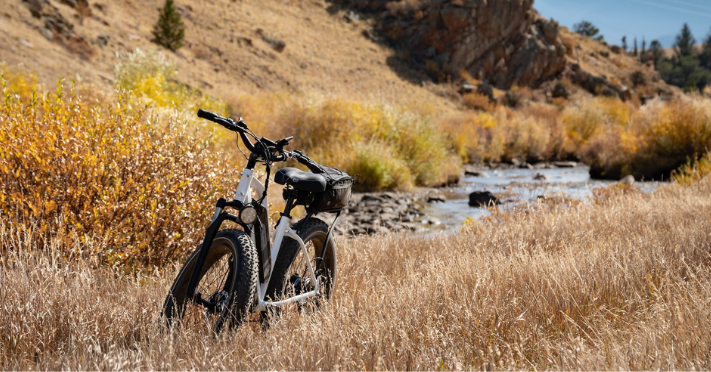One of the best ways to enjoy your electric bike to the maximum is to take it out into the wide open trails of the United States trails and nature reserves. However, until 2019, e-bike riders were banned from exploring state and national parks.
Nowadays, however, all e-bikes are allowed to take the trails of national parks, so long as they don’t exceed the 750-watt limit. So in this guide, we’ll explore the policies and park rules for riding e-bikes in national parks.
Introduction to E-Biking in State and National Parks
E-bike riders were often excluded from taking their vehicles on outdoor adventures in the nation’s state and national parks system. But that changed with a decree from the US Secretary of the Interior in 2019 ruling that enabled e-bike trails in parks. Then, a year later, the National Parks Service made e-bikes up to 750W legal in all parks where traditional bicycles are permitted.
The Growing Trend of E-Biking in Natural Reserves
E-bikes offer significant environmental benefits compared to bringing combustible vehicles like cars and motorbikes into remote areas like natural reserves. E-bikes don’t emit emissions and make very little noise. Therefore, encouraging their use is crucial to improving air quality, reducing traffic congestion, ensuring positive experiences for all park visitors, and keeping wildlife safe.
Advantages of E-Biking in Parks
The most significant benefit of riding an e-bike is it enables you to explore deeper into state and national parks than you possibly could on foot or a regular bicycle. Some e-bikes enable you to amass up to 100 miles on a single charge, giving you the freedom to explore as much of a national park as time allows.
Understanding the Regulations for E-Bikes in Parks
Despite e-bikes now being legal on park trails, all state parks are governed differently, so it’s essential to understand the rules before heading out on two wheels.
Federal Guidelines for E-Bike Use in National Parks
Federal guidelines enable you to take Class 1, 2, and 3 e-bikes onto national park trails. It defines this as two- or three-wheel e-bikes with fully operable pedals that can’t exceed 750W. That said, some national parks don’t have many off-road trails open to bikes, so there may not be too many options for e-mountain bikers.
State Regulations for E-Bike Use in State Parks
Regulations in state parks are more blurred, depending on specific state laws. For example, Virginia allows Class 1 and 2 e-bikes into its parks; California state parks have varying rules but typically only allow Class 1 e-bikes on trails; while Washington State allows all e-bikes on roads within state parks but only Class 1 and 3 bikes on specific trails. But most states will list rules and regulations on their websites.
You can also find out more about your local state park or plan ahead for a trip to a new park by visiting the National Park Service website. The site includes basic information about state parks along with details like alerts and park conditions. NPS also has apps for Apple and Android devices, enabling you to access all these resources on the go.
Etiquette and Safety when E-Biking in Parks
The more e-bike users respect the rules and prove the vehicles are park-friendly, the more likely states will relax their e-bike guidelines for park visits.
Best Practices for E-Biking Etiquette in Parks
When riding any trail, respecting fellow users, including hikers, bike riders, and runners, along with the surrounding nature and wildlife is vital. A few best practices for exploring state and national parks include:
- Passing etiquette: The additional power and speed of an e-bike means you’ll likely be passing regular bike riders, especially on hills. You must respect their right to ride by politely letting them know you’re passing and which side you intend to do so on. On narrow or tricky trails, show patience, and don’t try to push your way past.
- Stay on the trail: When riding e-bikes in national parks, it’s vital to stick to the designated trails. Just because you have a powerful e-mountain bike doesn’t give you the right to take it off the beaten track deep into the untouched countryside. Regulations in protected areas are there to maintain park restrictions for a reason. So stick to the rules, stay clear of areas with signs stating ‘hiking only’ or ‘no bikes,’ and watch for one-way trails.
- Keep parks tidy: Taking drinks and snacks into national parks is perfectly acceptable for you to get a little refreshment or have a picnic out in the wilderness. But ensure whatever you take into the park, you also take back with you, from plastic bags, food wrappers, and water bottles to a flat tire carcass.
Safety Considerations for E-Biking in Parks
Before heading out into nature exploration on your e-bike, you must consider a few safety considerations:
- Bike safety: If you’re new to riding e-bikes, take extra care with the vehicle. The battery and motor can easily add 20 lbs or more to the bike’s weight, so take care when mounting and dismounting to avoid damage to the bike and the nature around you.
- Safety equipment: You can also do your part to make all park trails safer by wearing the appropriate gear. Ensure your e-bike is fitted with functioning lights and reflectors, wear brightly colored or reflective clothing, wear a helmet, and consider other safety items like knee pads.
Respecting Wildlife and Natural Landscapes
A critical consideration when riding an e-bike through nature exploration is to respect the wild animals and natural surroundings. Never venture off trails into grassland or non-designated routes, even if you think your electric mountain bike can handle the rough terrain.
Overcoming Potential Challenges in E-Biking in Parks
Even the most respectful, safest riders can see their best intentions scuppered by changes in the weather or e-bike failures.
Planning and Preparation: Weather, Terrain, and Trails
Before heading out on a trail, planning park trips with electric bikes will help familiarize you with the route and any potential pitfalls. Carry a route map or download an app about the park if available, and, when on the trail, pay attention to other users, follow the rules of the road, and regularly interact with park staff.
Technical Challenges: Battery Life, Spare Parts, and Maintenance
E-bikes also carry the technical challenges of regular bicycles, such as flat tires or parts failures. So it’s crucial to ensure your battery is fully charged and take all the spare parts you may need to perform maintenance should the worse happen on a trail.
Adapting to Changing Regulations and Park Rules
The rules around e-bike access to state and national parks are evolving quickly. To prevent disappointment, check e-bike guidelines for park visits on the state park website before taking your e-bike out.
We recommend checking out the NPS website and mobile apps, as mentioned above. But you can also access mobile app resources like AllTrails, which contains maps of more than 200,000 trails worldwide and enables you to navigate trails on the go, and Chimani, which helps you find parks, access travel guides, and record your visits.
Whenever you head into a state or national park, sticking to the designated routes and following the park regulations and best practices will make trails safe for all users and, most importantly, protect nature and wildlife.



